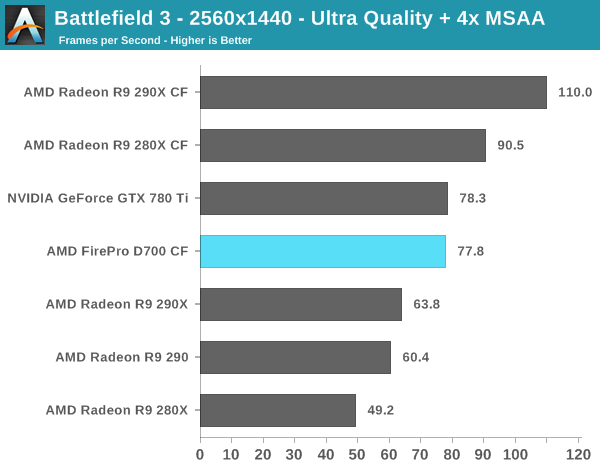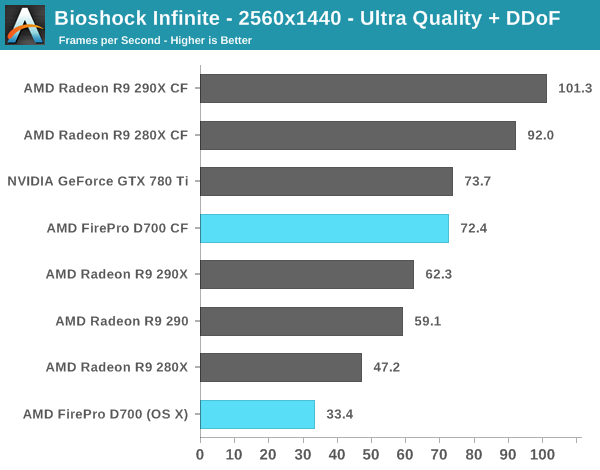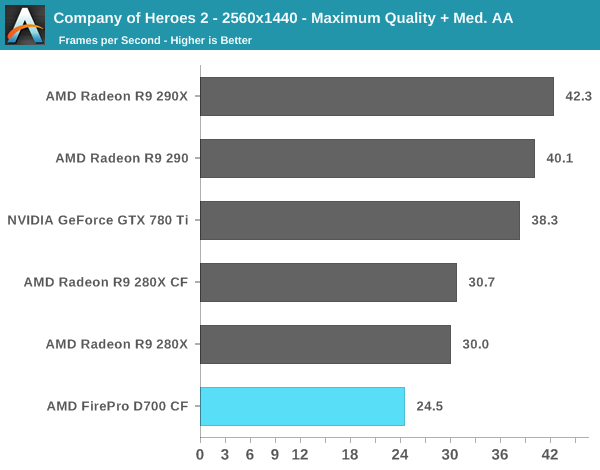The Mac Pro Review (Late 2013)
by Anand Lal Shimpi on December 31, 2013 3:18 PM ESTGaming Performance
As I mentioned earlier, under OS X games have to specifically be written to use both GPUs in the new Mac Pro. Under Windows however it's just a matter of enabling CrossFire X. I ran the new Mac Pro with dual FirePro D700s through a few of Ryan's 2014 GPU test suite games. The key comparison here is AMD's Radeon R9 280X CF. I've put all of the relevent information about the differences between the GPUs in the table below:
| Mac Pro (Late 2013) GPU Comparison | ||||||
| AMD Radeon R9 280X | AMD FirePro D700 | |||||
| SPs | 2048 | 2048 | ||||
| GPU Clock (base) | 850MHz | 650MHz | ||||
| GPU Clock (boost) | 1000MHz | 850MHz | ||||
| Single Precision GFLOPS | 4096 GFLOPS | 3481 GFLOPS | ||||
| Texture Units | 128 | 128 | ||||
| ROPs | 32 | 32 | ||||
| Transistor Count | 4.3 Billion | 4.3 Billion | ||||
| Memory Interface | 384-bit GDDR5 | 384-bit GDDR5 | ||||
| Memory Datarate | 6000MHz | 5480MHz | ||||
| Peak GPU Memory Bandwidth | 288 GB/s | 264 GB/s | ||||
| GPU Memory | 3GB | 6GB | ||||
Depending on thermal conditions the 280X can be as little as 17% faster than the D700 or as much as 30% faster, assuming it's not memory bandwidth limited. In the case of a memory bandwidth limited scenario the gap can shrink to 9%.
All of the results below are using the latest Radeon WHQL drivers at the time of publication (13-12_win7_win8_64_dd_ccc_whql.exe) running 64-bit Windows 8.1. Keep in mind that the comparison cards are all run on our 2014 GPU testbed, which is a 6-core Ivy Bridge E (i7-4960X) running at 4.2GHz. In other words, the other cards will have a definite CPU performance advantage (20 - 30% depending on the number of active cores).
You'll notice that I didn't run anything at 4K for these tests. Remember CrossFire at 4K is still broken on everything but the latest GCN 1.1 hardware from AMD.

Battlefield 3 starts out telling the story I expected to see. A pair of 280Xes ends up being 16% faster than the dual FirePro D700 setup in the Mac Pro. You really start to get an idea of where the Mac Pro's high-end GPU configuration really lands.

Bioshock ends up at the extreme end of what we'd expect to see between the 280X and D700. I tossed in a score from Bioshock under OS X, which obviously doesn't have CF working and ends up at less than half of the performance of the D700. If you're going to do any heavy 3D gaming, you'll want to do it under Windows still.

Not all games will scale well across multiple GPUs: Company of Heroes 2 is one of them. There's no performance uplift from having two 280Xes and thus the D700 performs like a slower single GPU R9 280X.


Metro is the one outlier in our test suite. Although CrossFire is clearly working under Windows, under Metro the D700 behaves as if it wasn't. I'm not sure what's going on here, but this does serve as a reminder that relying on multi-GPU setups to increase performance does come with a handful of these weird cases - particularly if you're using non-standard GPU configurations.










267 Comments
View All Comments
FunBunny2 - Tuesday, December 31, 2013 - link
Has everybody forgotten? This is just a Cube with one round corner. I suppose Tim will claim that's been patented too.newrigel - Wednesday, March 1, 2017 - link
Right.... with a unified core in it he he.... Mac's ruleY0ssar1an22 - Tuesday, December 31, 2013 - link
Off the Mac Pro topic but how come the 2013 13" rMBP scores significantly lower than the 2012 and various MBAs in the Cinebench 11.5? I'm personally interested as I have one on order :-) It scores better in later tests (so presumably not a typo?) Cinebench caught my eye as the first cross-benchmark in the review.Thanks for this review, and looking forward to the rMBPs in depth!
iwod - Tuesday, December 31, 2013 - link
1. What are the likely chances of a Mac that does Desktop Class Gfx card with 2 x8 PCI-E and uses Desktop Haswell instead. Unless i miss anything surely this is a simple change in production line.2. SSD speed is slow, for a Peak rate of 2GB/s, it seems Apple firmware or Samsung Controller not capable of feeling up the peak bandwidth? So which is likely the cause?
3. GFx ECC Ram. How much of a problem is it? For Professional market? And why Apple decide to ditch this since the price difference are minor for the price of Mac Pro.
dwade123 - Tuesday, December 31, 2013 - link
Who the **** put a trashcan here!?e375ued - Wednesday, January 1, 2014 - link
Is there some convenient reason Anand let the Mac Pro off easy by using Prime95 instead of Intel Burn Test or linpack?Ryan Smith - Wednesday, January 1, 2014 - link
It was my suggestion to try maxing out the Mac Pro, just to see if it would throttle (and if so, by how much). I picked Prime95 because it's good enough; not that there's anything wrong with IBT or Linpack, but all 3 of those are close enough that it shouldn't matter (and P95 is easy to use).jrs77 - Wednesday, January 1, 2014 - link
Good test that shows that the thermal core design works like a charm, even when applying very heavy and rather unrealistic loads to the system.Most people will run these new Mac Pros with only having a scene rendered or a video-filter applied etc and in this case the system is basically dead-silent and street-noise totally drowns the noise of the fan anyways.
Just a tad too expensive for me tho.
Kevin G - Wednesday, January 1, 2014 - link
The ‘mid range’ config is a far better value on the 2012 model since it is a 12 core model. The $200 savings can be put toward a better GPU.With regard to Cinebench, does it use AVX under OS X? I suspect that it does and that is where the majority of the single threaded CPU performance increase comes from. I strongly suspect that the single threaded performance advantage is far narrower in legacy code that doesn’t take advantage of AVX.
I’m glad the 2012 model was tested with a Radeon 7950. The ability to upgrade GPU’s matters and it’ll keep the 2012 model competitive for awhile. The system will support future video cards that come in from the PC side of things. With UEFI on video cards now, there is little difference between a Mac and PC version. For what it is worth, I have stuck an EVGA GTX 770 into a 2012 Mac Pro without issue and no modification on the video card or OS X drivers. It just works.
A bit of a random note is that the GPU connector used in the Mac Pro isn’t new to Apple: they used it for the G4 class daughter cards form 15 years back.
The PLX chip doesn’t have to do any port switching as a single GPU can drive up to 6 surfaces. That would imply the six DP signals from one GPU are routed in pairs to each of the Falcon Ridge controllers for encapsulation.
One shocking thing is that wall power draw exceeds that of the PSU’s DC rating. That is worrying as the system itself has only a 450W rated power supply. Due to the AC to DC conversion, there is an efficiency factor but the system has to be running close to its DC limit. Performing several file transfers over powered Thunderbolt devices could put the power draw beyond the rated DC limit. I wonder if Apple has implemented throttling based upon raw power consumption of the system as a whole in addition to temperature and power consumption of individual parts. Perhaps testing the system on a 240V AC circuit would alter things here as it is more efficient power delivery?
One aspect not accounted for is memory expansion. The 2009/2010/2012 Mac Pro’s will work with registered ECC memory which brings their maximum capacity up to 128 GB. Memory bandwidth too is superior in the dual socket 2010/2012 models: six channels of 1333 Mhz memory does have more bandwidth than four channels at 1866 Mhz. Going multi-socket does carry some overhead but still a bit of a disappointment that the theoretical number didn’t improve.
Bill Thompson - Wednesday, January 1, 2014 - link
My guess is the nVidia-based iMac is faster with After Effects and Premiere because of CUDA.Davinci Resolve has been updated for OpenCL, but I don't think Octane or Adobe apps have.
BTW, FCP X 10.1 displays multiple 4K streams in real time without rendering. It's a serious app.